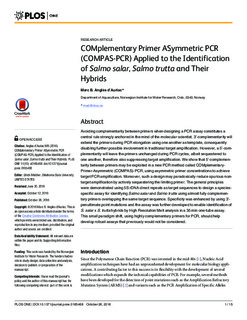| dc.contributor.author | Angles d'Auriac, Marc B | |
| dc.date.accessioned | 2018-08-01T12:47:24Z | |
| dc.date.available | 2018-08-01T12:47:24Z | |
| dc.date.created | 2017-02-14T21:57:14Z | |
| dc.date.issued | 2016 | |
| dc.identifier.citation | PLoS ONE. 2016, 11 (10), e0165468. | nb_NO |
| dc.identifier.issn | 1932-6203 | |
| dc.identifier.uri | http://hdl.handle.net/11250/2507157 | |
| dc.description.abstract | Avoiding complementarity between primers when designing a PCR assay constitutes a central rule strongly anchored in the mind of the molecular scientist. 3'-complementarity will extend the primers during PCR elongation using one another as template, consequently disabling further possible involvement in traditional target amplification. However, a 5'-complementarity will leave the primers unchanged during PCR cycles, albeit sequestered to one another, therefore also suppressing target amplification. We show that 5'-complementarity between primers may be exploited in a new PCR method called COMplementary-Primer-Asymmetric (COMPAS)-PCR, using asymmetric primer concentrations to achieve target PCR amplification. Moreover, such a design may paradoxically reduce spurious nontarget amplification by actively sequestering the limiting primer. The general principles were demonstrated using 5S rDNA direct repeats as target sequences to design a speciesspecific assay for identifying Salmo salar and Salmo trutta using almost fully complementary primers overlapping the same target sequence. Specificity was enhanced by using 3'-penultimate point mutations and the assay was further developed to enable identification of S. salar x S. trutta hybrids by High Resolution Melt analysis in a 35 min one-tube assay. This small paradigm shift, using highly complementary primers for PCR, should help develop robust assays that previously would not be considered. | nb_NO |
| dc.language.iso | eng | nb_NO |
| dc.publisher | Public Library of Science | nb_NO |
| dc.rights | Navngivelse 4.0 Internasjonal | * |
| dc.rights.uri | http://creativecommons.org/licenses/by/4.0/deed.no | * |
| dc.title | COMplementary Primer ASymmetric PCR (COMPAS-PCR) Applied to the Identification of Salmo salar, Salmo trutta and Their Hybrids | nb_NO |
| dc.type | Journal article | nb_NO |
| dc.type | Peer reviewed | nb_NO |
| dc.description.version | publishedVersion | nb_NO |
| dc.rights.holder | © 2016 Marc B. Anglès d'Auriac. | nb_NO |
| dc.source.pagenumber | 15 | nb_NO |
| dc.source.volume | 11 | nb_NO |
| dc.source.journal | PLoS ONE | nb_NO |
| dc.source.issue | 10 | nb_NO |
| dc.identifier.doi | 10.1371/journal.pone.0165468 | |
| dc.identifier.cristin | 1450594 | |
| dc.relation.project | Norsk institutt for vannforskning | nb_NO |
| cristin.unitcode | 7464,20,15,0 | |
| cristin.unitname | Akvakultur | |
| cristin.ispublished | true | |
| cristin.fulltext | original | |
| cristin.qualitycode | 1 | |

